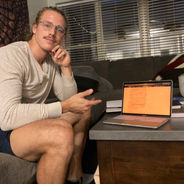Made to Move: The Holistic Benefits to Exercise
- Christian Van Camp

- Oct 9, 2019
- 6 min read
Updated: Oct 24, 2020
We often hear something beneficial about exercise and its impact on the body, mind & spirit. This accelerated movement balances our existence—our experience. We are designed to move.

Research reveals that there's a direct relationship between physical exercise and psychological health. We all know this, but why is it that only a small fraction of Americans exercise regularly?
A variety of physical improvements include a reduced risk of certain diseases, weight control, and an increase in strength, endurance, & flexibility.
Psychological health benefits consist of improved mood, reduced amount of stress, and boosted self-esteem.
Okay, we all know we need to hop up off our tushie and get moving...
So why are we so damn sedentary?
One reason: Comfort.
We love being comfortable.
When we push our body and brain through the extremes, comfort dissipates. However, this dissipation makes room for mental and physical growth, maturation, and development.
Being uncomfortable is the key to success. Sounds counterintuitive, but how do you think the most successful people in the world built such a massive following of individuals?
Prime examples of individuals with this trait include the amazing Ben Greenfield, Alex Morgan, Joe Rogan, Josh Axe, Joe Dispenza, Kevin Parker, and Amanda Meixner.
It's a big part of boosting performance, creativity, and open-mindedness. Without feelings of uneasiness, there would be no blissfulness.
Pertaining to physical health, exercise significantly alters the way the human body functions. The benefits of physical activity primarily focus on reducing the risk of many diseases; including neurodegenerative.
Aerobic exercise, such as running or jogging, has been shown to be beneficial to patients with Alzheimer’s disease by improving oxidative stress regulation, autophagy systems (immune health), neurotrophic signaling, neurogenesis, and mitochondrial biogenesis. Exercise (especially high intensity), helps maintain brain function, repair motor neurons, and increase long-term memory formation. These all have a major impact, not only on Alzheimer’s patients, but everybody AND every body.
Other than the cognitive enhancement from physical activity, other common bodily diseases can be assessed. For instance, regular exercise, such as weightlifting (anaerobic) & jogging (aerobic), can treat and prevent diabetes by regulating insulin response and keeping healthy blood sugar levels, while maintaining weight and increasing daily energy.
According to the American Heart Association, over 250,000 deaths occur every year in the U.S. because of a lack of regular physical exercise and less than a third of Americans meet the recommended amount by the CDC, ACSM, and AHA. Many of these deaths are a result of a weak heart & lead to a decline in cardiovascular health; otherwise known as heart disease. This exhibits the seriousness of exercise and how sitting for long periods (sedentary living) can cause major health issues.
Some risk factors of cardiovascular disease include high blood pressure, blood lipid abnormalities, smoking, and obesity. However, regular exercise can help combat these problems that can lead to stroke or heart attack and has been shown to promote weight loss while reducing “bad” LDL cholesterol and boosting “healthy” HDL cholesterol.
These health improvements from physical fitness, such as lowering neurodegeneration, increasing heart capacity, and controlling a healthy weight, will simultaneously build endurance, strength, and flexibility and can promote a higher quality of life.
A Little Tangent on Cholesterol
The ironic part is that LDL "cholesterol" isn't cholesterol at all. It's the "lipoprotein" taxi for it. Lipoproteins carry the cholesterol particles throughout the body, and the one reason LDL gets a bad rep is because it carries cholesterol to the cells in our body through the bloodstream (HDL on the other hand carries cholesterol away to the liver for flushing out of the body).
Therefore, people are so concerned with lowering their cholesterol (LDL) because it is the one guy that can cause plaque buildup in our arteries. HOWEVER, without Low-Density Lipoprotein... we would be dead.
So rejoice for cholesterol and lipoproteins!
Engaging in the slightest amount of physical activity at any age has been shown to improve cognitive functioning (especially emotional state/mood), increase energy, and boost self-esteem.
The Surgeon General’s Report states that regular exercise includes roughly 30 minutes every day of moderate intensity of 3-6 METs (multiples of the resting metabolic rate), or 600-1200 calories per week, including activities such as cycling and yard work (Myers). That is the recommended minimum time and energy expenditure needed to achieve optimal health.
Yet, after 30 minutes of vigorous exercise, studies show that circulating sympathetic amines increased 2-6x over resting levels. An increase in these brain opiates from exercise can lessen depression and help promote higher levels of neurotransmitters (such as dopamine and serotonin), which shows how crucial physical activity is for emotional stability.
I totally believe this research based on anecdotal evidence. Personally, it's always starting the workout, whether it's weightlifting or running, that is the most challenging. After 20-30 minutes getting into the rhythm and pace of the exercise, I feel like the Roadrunner and have this locked-in mentality. My brain is quite literally on one, with a clean, sharp, and stable-minded high. I truly feel my true self.
My personality pops in conversations and I simply express internal gratitude to all life. It all comes down to breath and massive amounts of oxygen being pumped through your veins. O2 fuels your brain, body, and soul. Sounds like a cliche, hippy quote? That’s because it is.

Depression plays a significant role in our western society and an abundance of these depressed individuals do not implement exercise in their regimen.
James Blumenthal, PhD (a clinical psychologist at Duke University) conducted an experimental study on adults with Major Depressive Disorder and put them into one of four groups; supervised-exercise, home-based exercise, antidepressant therapy, and a group given a placebo pill.
Four months later, patients in both exercise and antidepressant group “had higher rates of remission” than the placebo group and a follow-up a year later, the patients who continued this regular exercise showed even lower signs of depression compared to counterparts.
This experiment gave insight on the power exercise plays on treating depression, and how it also prevents relapse.
Exercise can become a critical part of a daily routine and provide a positive outlook for depressed individuals while giving them “a sense of accomplishment." Once you go for a month consistently, you'll be locked into this life-altering experience.
A fundamental ingredient to a healthy lifestyle is good self-esteem; however, obesity and inactivity tend to discourage oneself and disrupt self-confidence.
Exercise steps in as a crucial component in constructing pride for one’s body and releasing that sense of well-being.
And it does not take much to break a set-declining mindset.
Roughly 30 minutes of aerobic activity (such as swimming, jogging, or walking) can release beta-endorphins that increase positive feelings and lower chronic cortisol levels (a hormone released when under stress and anxiety).
According to “The Internet Journal of Allied Health Sciences and Practices” and research by scientists at Nova Southeastern University, “low- to moderate-intensity aerobic exercise produced positive results in mood improvement and psychological functioning."
Lifting weights, sprinting, swimming, or even mowing the lawn can create more defined muscle tone, better one’s posture, and balance weight, which adds a sense of accomplishment.
Not only does aerobic exercise succeed in uplifting self-image, but yoga, tai chi, and other forms of bodily meditation can help improve mental functions.
In a Livestrong.com article, “yoga practice… lowers levels of cortisol and adrenaline, and helps to regulate blood sugar, blood pressure, insulin resistance, and the ‘food seeking behavior’ inspired by stress that leads to weight gain and added abdominal fat. This form of meditation stimulates the prefrontal cortex that controls happiness levels and healthy immune function."
Calming the body and mind to relieve stress from the chaotic outside world is an effective way to live comfortably in one’s unique skin.
Physical activity is medicine for the mind. It improves mood, reduces stress and depression, and betters a person’s self-esteem and confidence tremendously.
The advantages of exercise exceed far beyond weight-loss and reaching that ‘bikini-bod’ look.
Many people choose to implement the gym—or park trails—to gain muscle, improve cardiovascular strength, and to admire oneself in the mirror.
However, these aren’t the only benefits from incorporating fitness as a lifestyle. It can considerably boost not only one’s physical health, but psychological.
Disease prevention, increase in energy and stamina, better mood and thinking, and overall confidence as an individual, are a few of the many side-effects.
Anyways, don't take my word for it. Go out there and grasp that euphoric endorphin-rush stacked with a hormone-cocktail containing elevated levels of serotonin, dopamine, epinephrine, norepinephrine, cortisol, HGH, IGF, and BDNF.
Research continually proves that this motivation-to-get-moving instantly aids the body and mind in numerous ways.
As Daniel Wolpert states, “We have a brain for one reason and one reason only — and that’s to produce adaptable and complex movements.”
Humans are meant to move.
Citations
Crawford, B. (2017, September 11). How Does Exercise Affect Your Self-Esteem? https://www.livestrong.com/article/438937-how-does-exercise-affect-your-self-esteem/.
Garatachea, N., Pareja-Galeano, H., Sanchis-Gomar, F., Santos-Lozano, A., Fiuza-Luces, C., Morán, M., … Lucia, A. (2015). Exercise Attenuates the Major Hallmarks of Aging. Rejuvenation Research, 18(1), 57–89. http://doi.org/10.1089/rej.2014.1623.
Humans are meant to move. (n.d.). http://www.benmedder.com/movement/.
Mayo Clinic Staff. (2015, June 20). What you need to know about exercise and chronic disease. http://www.mayoclinic.org/healthy-lifestyle/fitness/in-depth/exercise-and-chronic-disease/art-20046049.
Myers, J. (2003, January 07). Exercise and Cardiovascular Health. http://circ.ahajournals.org/content/107/1/e2.
Nieman, P. (2002, May & June). Psychosocial aspects of physical activity. https://www.ncbi.nlm.nih.gov/pmc/articles/PMC2795619/.
Weir, K. (2011, December). The exercise effect. http://www.apa.org/monitor/2011/12/exercise.aspx.

































Comments